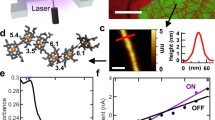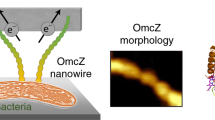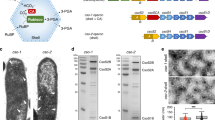Abstract
Engineering bioelectronic components and set-ups that mimic natural systems is extremely challenging. Here we report the design of a protein-only redox film inspired by the architecture of bacterial electroactive biofilms. The nanowire scaffold is formed using a chimeric protein that results from the attachment of a prion domain to a rubredoxin (Rd) that acts as an electron carrier. The prion domain self-assembles into stable fibres and provides a suitable arrangement of redox metal centres in Rd to permit electron transport. This results in highly organized films, able to transport electrons over several micrometres through a network of bionanowires. We demonstrate that our bionanowires can be used as electron-transfer mediators to build a bioelectrode for the electrocatalytic oxygen reduction by laccase. This approach opens opportunities for the engineering of protein-only electron mediators (with tunable redox potentials and optimized interactions with enzymes) and applications in the field of protein-only bioelectrodes.
This is a preview of subscription content, access via your institution
Access options
Subscribe to this journal
Receive 12 print issues and online access
$259.00 per year
only $21.58 per issue
Buy this article
- Purchase on Springer Link
- Instant access to full article PDF
Prices may be subject to local taxes which are calculated during checkout




Similar content being viewed by others
References
Malvankar, N. S. & Lovley, D. R. Microbial nanowires: a new paradigm for biological electron transfer and bioelectronics. ChemSusChem 5, 1039–1046 (2012).
Qian, F. & Li, Y. Biomaterials: a natural source of nanowires. Nat. Nanotechnol. 6, 538–539 (2011).
Pfeffer, C. et al. Filamentous bacteria transport electrons over centimetre distances. Nature 491, 218–221 (2012).
Reardon, P. N. & Mueller, K. T. Structure of the type IVa major pilin from the electrically conductive bacterial nanowires of Geobacter sulfurreducens. J. Biol. Chem. 288, 29260–29266 (2013).
Malvankar, N. S., Tuominen, M. T. & Lovley, D. R. Lack of cytochrome involvement in long-range electron transport through conductive biofilms and nanowires of Geobacter sulfurreducens. Energy Environ. Sci. 5, 8651–8659 (2012).
Malvankar, N. S., Tuominen, M. T. & Lovley, D. R. Comment on ‘On electrical conductivity of microbial nanowires and biofilms’. Energy Environ. Sci. 5, 6247–6249 (2012).
Bonanni, P. S., Massazza, D. & Busalmen, J. P. Stepping stones in the electron transport from cells to electrodes in Geobacter sulfurreducens biofilms. Phys. Chem. Chem. Phys. 15, 10300–10306 (2013).
Strycharz-Glaven, S. M., Snider, R. M., Guiseppi-Elie, A. & Tender, L. M. On the electrical conductivity of microbial nanowires and biofilms. Energy Environ. Sci. 4, 4366–4379 (2011).
Knowles, T. P. J. & Buehler, M. J. Nanomechanics of functional and pathological amyloid materials. Nat. Nanotechnol. 6, 469–479 (2011).
Mankar, S., Anoop, A., Sen, S. & Maji, S. K. Nanomaterials: amyloids reflect their brighter side. Nano Rev. 2, 6032–6043 (2011).
Gras, S. L. in Advances in Chemical Engineering Vol. 35 (ed. Rudy, J. K.) 161–209 (Academic, 2009).
Scheibel, T. et al. Conducting nanowires built by controlled self-assembly of amyloid fibers and selective metal deposition. Proc. Natl Acad. Sci. USA 100, 4527–4532 (2003).
Kholkin, A., Amdursky, N., Bdikin, I., Gazit, E. & Rosenman, G. Strong piezoelectricity in bioinspired peptide nanotubes. ACS Nano 4, 610–614 (2010).
Amit, M. et al. Hybrid proton and electron transport in peptide fibrils. Adv. Funct. Mater. 24, 5873–5880 (2014).
Berger, O. et al. Light-emitting self-assembled peptide nucleic acids exhibit both stacking interactions and Watson–Crick base pairing. Nat. Nanotechnol. 10, 353–360 (2015).
del Mercato, L. L. et al. Charge transport and intrinsic fluorescence in amyloid-like fibrils. Proc. Natl Acad. Sci. USA 104, 18019–18024 (2007).
Amit, M., Cheng, G., Hamley, I. W. & Ashkenasy, N. Conductance of amyloid-based peptide filaments: structure & function relations. Soft Matter 8, 8690–8696 (2012).
Creasey, R. C. G., Shingaya, Y. & Nakayama, T. Improved electrical conductance through self-assembly of bioinspired peptides into nanoscale fibers. Mater. Chem. Phys. 158, 52–59 (2015).
Domigan, L. J., Healy, J. P., Meade, S. J., Blaikie, R. J. & Gerrard, J. A. Controlling the dimensions of amyloid fibrils: toward homogenous components for bionanotechnology. Biopolymers 97, 123–133 (2012).
Herland, A. et al. Electroactive luminescent self-assembled bio-organic nanowires: integration of semiconducting oligoelectrolytes within amyloidogenic proteins. Adv. Mater. 17, 1466–1471 (2005).
Rizzo, A., Solin, N., Lindgren, L. J., Andersson, M. R. & Inganäs, O. White light with phosphorescent protein fibrils in OLEDs. Nano Lett. 10, 2225–2230 (2010).
Bolisetty, S., Adamcik, J., Heier, J. & Mezzenga, R. Amyloid directed synthesis of titanium dioxide nanowires and their applications in hybrid photovoltaic devices. Adv. Funct. Mater. 22, 3424–3428 (2012).
Li, C., Adamcik, J. & Mezzenga, R. Biodegradable nanocomposites of amyloid fibrils and graphene with shape-memory and enzyme-sensing properties. Nat. Nanotechnol. 7, 421–427 (2012).
Baldwin, A. J. et al. Cytochrome display on amyloid fibrils. J. Am. Chem. Soc. 128, 2162–2163 (2006).
Saupe, S. J. The [Het-s] prion of Podospora anserina and its role in heterokaryon incompatibility. Semin. Cell Dev. Biol. 22, 460–468 (2011).
Balguerie, A. et al. Domain organization and structure–function relationship of the HET-s prion protein of Podospora anserina. EMBO J. 22, 2071–2081 (2003).
Wasmer, C. et al. Amyloid fibrils of the HET-s(218–289) prion form a β solenoid with a triangular hydrophobic core. Science 319, 1523–1526 (2008).
Meyer, J. Iron–sulfur protein folds, iron–sulfur chemistry, and evolution. J. Biol. Inorg. Chem. 13, 157–170 (2008).
Solomon, E. I., Sundaram, U. M. & Machonkin, T. E. Multicopper oxidases and oxygenases. Chem. Rev. 96, 2563–2606 (1996).
Van Melckebeke, H. et al. Atomic-resolution three-dimensional structure of HET-s(218–289) amyloid fibrils by solid-state NMR spectroscopy. J. Am. Chem. Soc. 132, 13765–13775 (2010).
Bonisch, H., Schmidt, C. L., Bianco, P. & Ladenstein, R. Ultrahigh-resolution study on Pyrococcus abyssi rubredoxin. I. 0.69 A X-ray structure of mutant W4L/R5S. Acta Cryst. D 61, 990–1004 (2005).
Page, C. C., Moser, C. C., Chen, X. & Dutton, P. L. Natural engineering principles of electron tunnelling in biological oxidation-reduction. Nature 402, 47–52 (1999).
Winkler, J. R. & Gray, H. B. Long-range electron tunneling. J. Am. Chem. Soc. 136, 2930–2939 (2014).
Sabaté, R. et al. Prion and non-prion amyloids of the HET-s prion forming domain. J. Mol. Biol. 370, 768–783 (2007).
Doussineau, T. et al. Mass determination of entire amyloid fibrils by using mass spectrometry. Angew. Chem. Int. Ed. 55, 2340–2344 (2016).
Siemer, A. et al. 13C, 15N resonance assignment of parts of the HET-s prion protein in its amyloid form. J. Biomol. NMR 34, 75–87 (2006).
Mizuno, N., Baxa, U. & Steven, A. C. Structural dependence of HET-s amyloid fibril infectivity assessed by cryoelectron microscopy. Proc. Natl Acad. Sci. USA 108, 3252–3257 (2011).
Mao, F., Mano, N. & Heller, A. Long tethers binding redox centers to polymer backbones enhance electron transport in enzyme ‘wiring’ hydrogels. J. Am. Chem. Soc. 125, 4951–4957 (2003).
Bard, A. J. & Faulkner, L. R. in Electrochemical Methods: Fundamentals and Applications 2nd edn (eds Allen, J. & Bard, L. R. F.) 580 (John Wiley & Sons, 2001).
Laviron, E. A multilayer model for the study of space distributed redox modified electrodes. Part I. Description and discussion of the model. J. Electroanal. Chem. Interfacial Electrochem. 112, 1–9 (1980).
Blauch, D. N. & Saveant, J. M. Dynamics of electron hopping in assemblies of redox centers. Percolation and diffusion. J. Am. Chem. Soc. 114, 3323–3332 (1992).
Andrieux, C. P. & Savéant, J. M. Electron transfer through redox polymer films. J. Electroanal. Chem. Interfacial Electrochem. 111, 377–381 (1980).
Barsoukov, E. & Macdonald, J. R. Impedance Spectroscopy: Theory, Experiment, and Applications 2nd edn (John Wiley & Sons, 2005).
Gabrielli, C., Haas, O. & Takenouti, H. Impedance analysis of electrodes modified with a reversible redox polymer film. J. Appl. Electrochem. 17, 82–90 (1987).
Musiani, M. M. Characterization of electroactive polymer layers by electrochemical impedance spectroscopy (EIS). Electrochim. Acta 35, 1665–1670 (1990).
Ho, C., Raistrick, I. D. & Huggins, R. A. Application of A-C techniques to the study of lithium diffusion in tungsten trioxide thin films. J. Electrochem. Soc. 127, 343–350 (1980).
Bisquert, J., Garcia-Belmonte, G., Bueno, P., Longo, E. & Bulhões, L. O. S. Impedance of constant phase element (CPE)-blocked diffusion in film electrodes. J. Electroanal. Chem. 452, 229–234 (1998).
Criado, C., Galán-Montenegro, P., Velásquez, P. & Ramos-Barrado, J. R. Diffusion with general boundary conditions in electrochemical systems. J. Electroanal. Chem. 488, 59–63 (2000).
Ordinario, D. D. et al. Bulk protonic conductivity in a cephalopod structural protein. Nat. Chem. 6, 596–602 (2014).
Malvankar, N. S. et al. Tunable metallic-like conductivity in microbial nanowire networks. Nat. Nanotechnol. 6, 573–579 (2011).
Rengaraj, S., Kavanagh, P. & Leech, D. A comparison of redox polymer and enzyme co-immobilization on carbon electrodes to provide membrane-less glucose/O2 enzymatic fuel cells with improved power output and stability. Biosens. Bioelectron. 30, 294–299 (2011).
Rubenwolf, S. et al. Carbon electrodes for direct electron transfer type laccase cathodes investigated by current density–cathode potential behavior. Biosens. Bioelectron. 26, 841–845 (2010).
Feifel, S. C., Kapp, A. & Lisdat, F. Electroactive nanobiomolecular architectures of laccase and cytochrome c on electrodes: applying silica nanoparticles as artificial matrix. Langmuir 30, 5363–5367 (2014).
Feifel, S. C., Kapp, A., Ludwig, R. & Lisdat, F. Nanobiomolecular multiprotein clusters on electrodes for the formation of a switchable cascadic reaction scheme. Angew. Chem. Int. Ed. 53, 5676–5679 (2014).
Winkler, J. R., Gray, H. B., Prytkova, T. R., Kurnikov, I. V. & Beratan, D. N. in Bioelectronics: From Theory to Applications (eds Willner, I. & Katz, E.) 15–33 (Wiley-VCH, 2005).
Piontek, K., Antorini, M. & Choinowski, T. Crystal structure of a laccase from the fungus Trametes versicolor at 1.90-Å resolution containing a full complement of coppers. J. Biol. Chem. 277, 37663–37669 (2002).
Le Goff, A., Holzinger, M. & Cosnier, S. Enzymatic biosensors based on SWCNT-conducting polymer electrodes. Analyst 136, 1279–1287 (2011).
Holzinger, M., Le Goff, A. & Cosnier, S. Carbon nanotube/enzyme biofuel cells. Electrochim. Acta 82, 179–190 (2012).
Daniels, J. S. & Pourmand, N. Label-free impedance biosensors: opportunities and challenges. Electroanalysis 19, 1239–1257 (2007).
Acknowledgements
We thank D. Fenel and G. Schoehn from the IBS/UVHCI platform of the Partnership for Structural Biology in Grenoble (PSB/IBS) for the electron microscopy. We thank S. Saupe for the gift of pET24a(+)-HET-s(218-289)-His6 and S. Crouzy for his help in building the structural model. AFM measurements were performed on the Commissariat à l'énergie atomique (CEA) Minatec Nanocharacterization Platform (PFNC). The present work was also partially supported by the Labex ARCANE (ANR-11-LABX-0003-01). L.A. and A.R are indebted to CEA for the funding of their PhD fellowships. V.F. and P.R. thank N. Mermilliod and E. Molva, respectively heads of the Transverse Energy and the Nanoscience programs of the CEA, for their scientific and financial support. We thank T. Martin for the careful reading of the manuscript.
Author information
Authors and Affiliations
Contributions
C.H., N.D., M.F. and V.F. realized the design of the protein nanowire. C.H., L.A. and N.D. developed the protocol for the chimeric protein production in bacteria and purification. C.H., L.A., C.V., D.M., V.B., N.D. and V.F. performed the biophysical characterization of the bionanowires. S.R., L.A., K.E., C.G., A.L.B.M., A.L.-G., M.H. and N.D. carried out the electrochemical characterization of the bionanowires and L.A., A.R. and P.R. performed the electrical characterizations of the bionanowires. S.R., K.E., A.L.-G. and M.H. designed the electrode functionalized with nanowires and laccase and realized the experiments. M.F., V.B., M.H. and V.F. were responsible for the project management. L.A., S.R., A.L.-G. and V.F. prepared the manuscript. All the authors discussed the results and commented on the manuscript.
Corresponding authors
Ethics declarations
Competing interests
The authors declare no competing financial interests.
Supplementary information
Supplementary information
Supplementary information (PDF 1101 kb)
Rights and permissions
About this article
Cite this article
Altamura, L., Horvath, C., Rengaraj, S. et al. A synthetic redox biofilm made from metalloprotein–prion domain chimera nanowires. Nature Chem 9, 157–163 (2017). https://doi.org/10.1038/nchem.2616
Received:
Accepted:
Published:
Issue Date:
DOI: https://doi.org/10.1038/nchem.2616
This article is cited by
-
Moving towards the enhancement of extracellular electron transfer in electrogens
World Journal of Microbiology and Biotechnology (2023)
-
Living electronics
Nano Research (2020)
-
How does electron transfer occur in microbial fuel cells?
World Journal of Microbiology and Biotechnology (2020)
-
Ultraviolet–visible–near-infrared optical properties of amyloid fibrils shed light on amyloidogenesis
Nature Photonics (2019)
-
Nanoscale Control of Amyloid Self-Assembly Using Protein Phase Transfer by Host-Guest Chemistry
Scientific Reports (2017)



